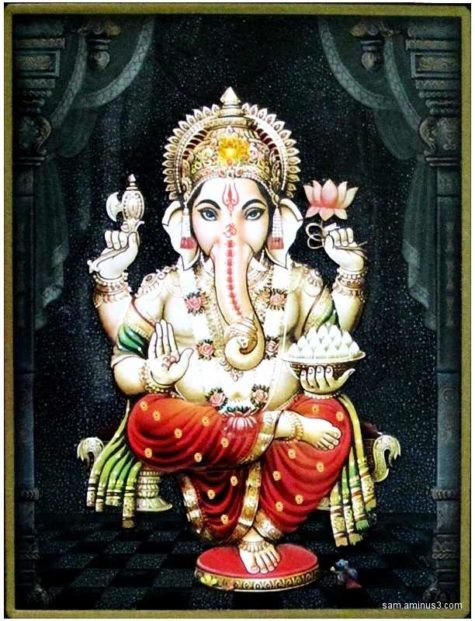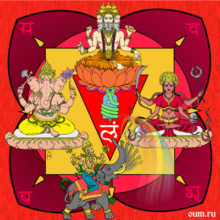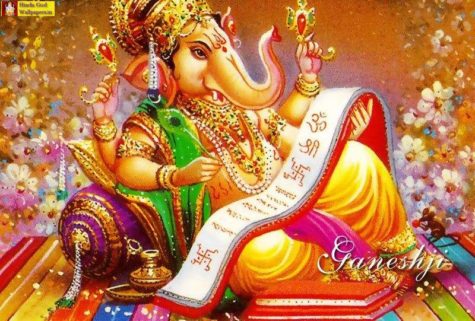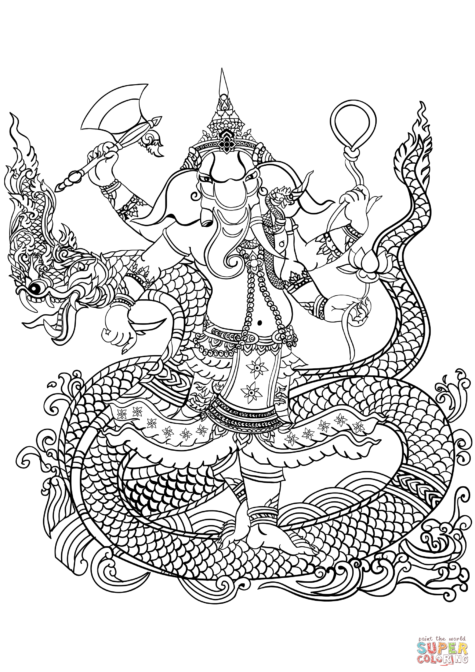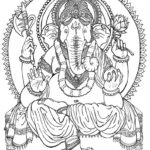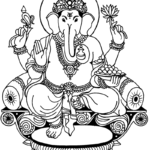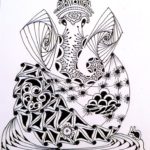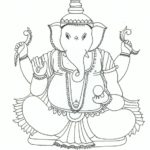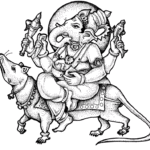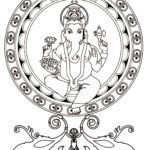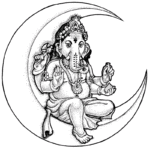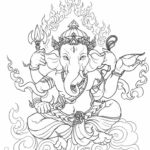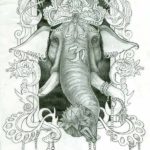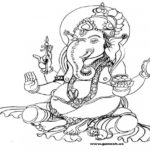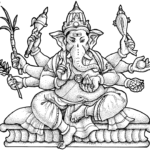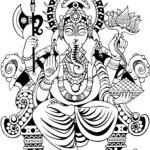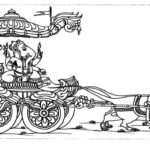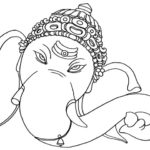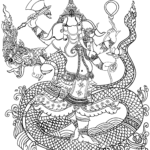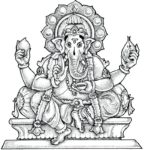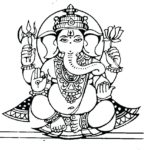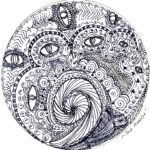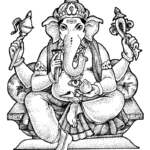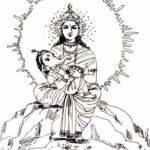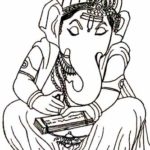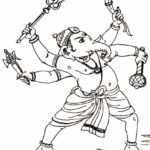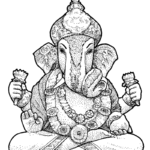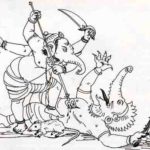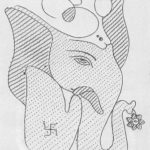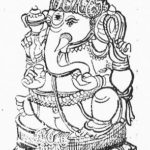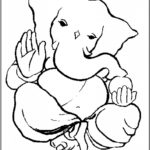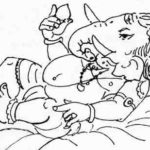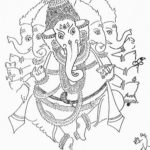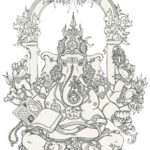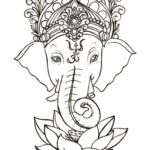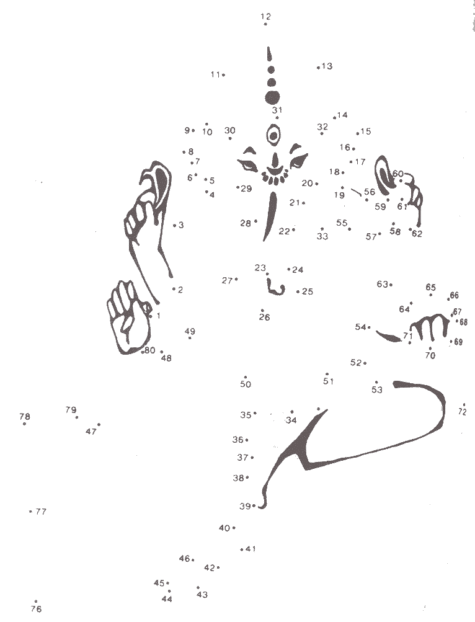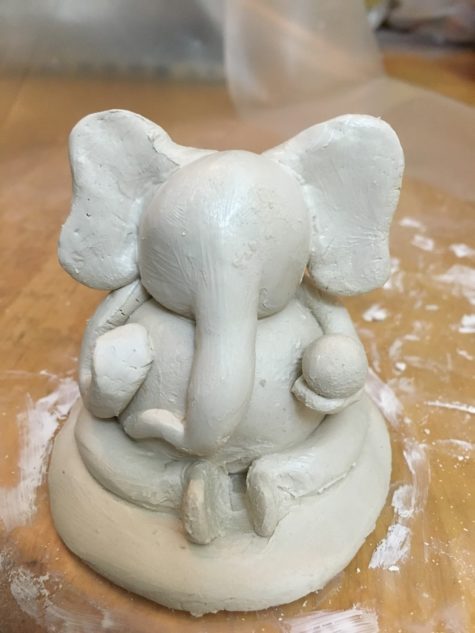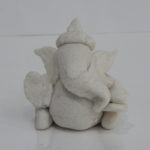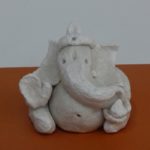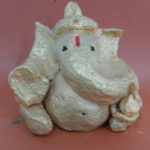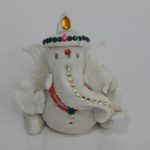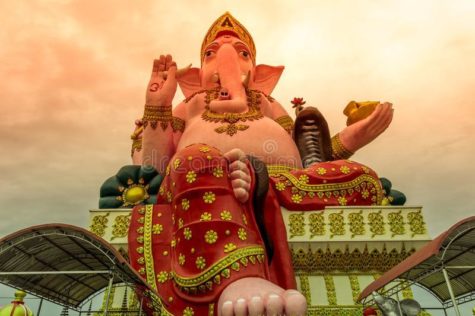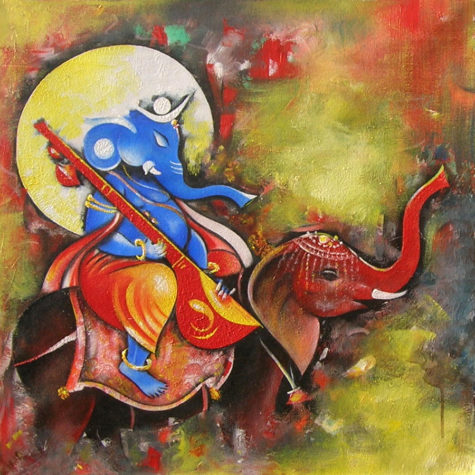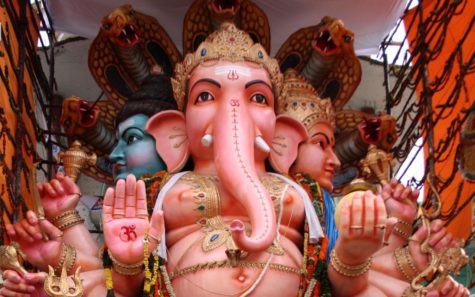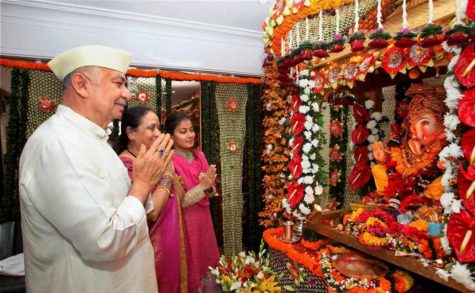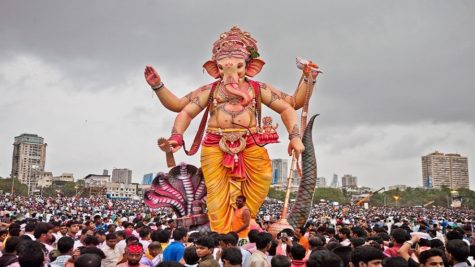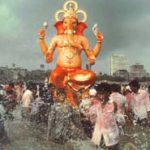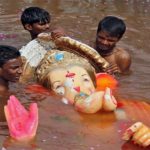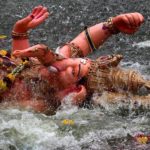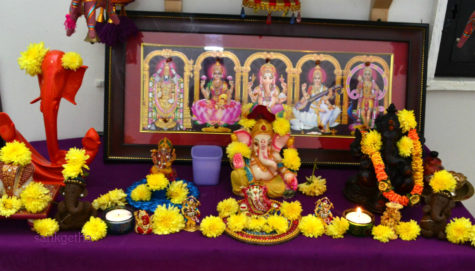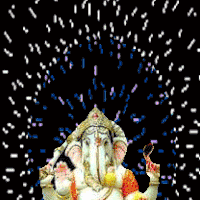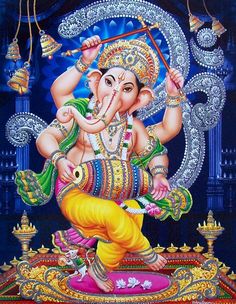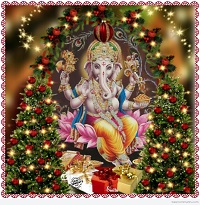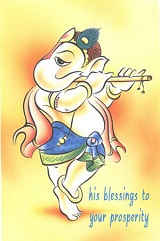Monthly Archives: September 2018
The 108 Names of Ganesha
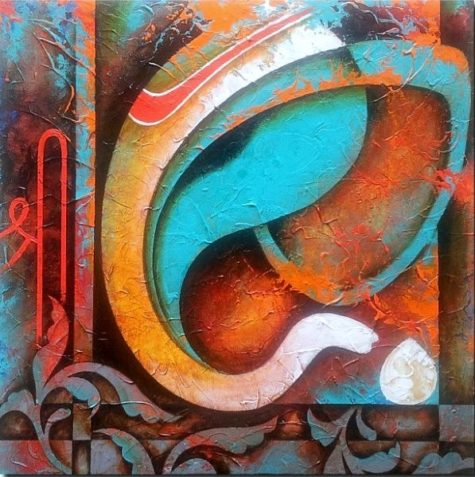
Chanting the 108 names of Lord Ganesha is part of the traditional daily worship called a Puja. It is called the Vighnesvarashtottara Satanamavalihor “garland of Ganesa’s 108 names”. The names are attributes of the Diety, each one delineating an aspect of His infinite and indescribable nature.
Each name is preceded by the mantra Aum (Om) and followed by namah (Namaha) meaning “obeisance, praise, adoration,” or “homage” to.
![]()
Aum Akhuratha Namah
One With Mouse As His Charioteer
Lord Ganesha, with a huge body, has a small mouse as his charioteer. The hugeness matters little when the study of life principles is considered. The soul may be the greatest or the smallest. This represents life in its totality and Lord Ganesha is suggestive of these cosmic aspects.
![]()
Aum Alampata Namah
The Eternal
By whose puissance this world of illusion is manifest, whose creation is this universe, who is the Lord of all gods and creation, he is the Eternal, Lord Ganesha.
![]()
Aum Amit Namah
One Who Has No Comparison
Ganesha is the embodiment of ‘OM’, the symbol of the Great God. He is the Eternal Spirit, the Beginning of all beginnings, beyond comparison.
![]()
Aum Anantachidrupamayam Namah
Infinite And Consciousness Personified
He who is the root cause of the worlds, who is uniquely manifest in the hearts of all, can be realized only by concentrated meditation. Lord Ganesha, the Infinite, is beyond distinctions and beginning.
![]()
Aum Avaneesh Namah
Master Of The Whole Earth
As a rotund, elephant-faced figure, Lord Ganesha is the Lord and Master of the whole earth.He is the protector of the visible world and leader of the helpless, destroying all evil and obstacles.
![]()
Aum Avighna Namah
Without Obstacles
The mighty, massive Ganesha, mounted on his vehicle, bestows everything desired if his devotees chant his name with fervor and devotion; He is also responsible in keeping away all obstacles from their path.
![]()
Aum Balaganapati Namah
The Beloved Child
Lord Ganesha is adored by all the gods, even by the four-faced Brahma, and Lord Indra. As the elephant-faced child, he is the color of the rays of the rising sun.
![]()
Aum Bhalchandra Namah
Sporting The Moon Crest
A moon crest adorns the forehead of Lord Ganesha. It denotes a pot of nectar, providing divine coolness to the wearer. It also denotes intelligence and mental, enlightenment, the moon being the symbol of mind and peace.
![]()
Aum Bheema Namah
Gigantic
The massive Lord Ganesha reposes on the jeweled throne with the snare, the hamulus and the lotus flower in his hands. On his forehead reposes the moon. He is four-armed, has a single tusk, a trunk askew, a potbelly and he is gigantic.
![]()
Aum Bhoopati Namah
Lord Of The Lords
Bhoopati, also called Ganapati, is the Lord of the lords, the Master of the ganas or celestial hordes. He is worshiped by Brahma himself and is worshiped in all the three worlds.
![]()
Aum Bhoovanpati Namah
Lord Of The Lords
Bhoovanpati is the Great God Himself to whom even the Trinity – Vishnu the Protector, Shiva the Destroyer and Brahma the Creator – pay obeisance and propitiate Him to save the world from evil.
![]()
Aum Buddhinath Namah
Lord Of Wisdom
Lord Ganesha, the Lord of wisdom is the repository of all knowledge. His illimitable erudition makes even Goddess Saraswati and Sage Narada bow their heads in awe.
![]()
Aum Buddhipriya Namah
Bestower Of Knowledge
Buddhipriya, the repository of knowledge, bestows guileless discretion to the worshiper. As ruler of the Mooladhara Chakra or plexus, he arouses a person’s latent energy or life force to take him to the Divine Light.
![]()
Aum Buddhividhata Namah
God Of Wisdom
By chanting Lord Ganesha’s name day in and day out, one gets richer by imbibing all knowledge and wisdom from him, who is of enlightened heart and unwavering wisdom.
![]()
Aum Chaturbhujeti Namah
Four-Armed
The four-armed Ganesha is an embodiment of truth, discretion, having control over money power and bondage. These four arms represent the four castes: Brahmin, Kshatriya, Vaishya and Shudra, symbolically indicating his divinity.
![]()
Aum Devadeva Namah
Lord of All Lords
Lord Ganesha is the Master of all. He is always worshiped in the three worlds by all, and is the first to be reverenced among the celestials.
![]()
Aum Devantakanashakarin Namah
Destroyer Of Demons
Lord Ganesha, the Destroyer of evils slew the powerful demons, re-establishing righteousness and peace in the three worlds.
![]()
Aum Devavrata Namah
Accepter of All Penances
The elephant-faced Ganesha is propitiated by all as He is Auspiciousness personified. He is the granter of boons and -responds to penances of his devotees.
![]()
Aum Devendrashika Namah
Protector Of the Gods
Lord Ganesha, Protector of the gods is their beloved. With a large form, who has the mouse as his vehicle, he is the embodiment of peace and tranquility-the giver of peace to all.
![]()
Aum Dharmik Namah
One Who Favors Charity
The Great Lord Ganesha is gentle, forgiving and compassionate. He likes to prod man with his goad to the path of righteousness and truth so that he can learn to be charitable.
![]()
Aum Dhoomravarna Namah
Smoke-Colored Body
The smoke-hued Ganesha is the beloved Lord of gods and mortals. His body is sometimes compared with a red lotus. His hands are ornamented with gem-studded bangles and his whole smoke-colored image is enchanting.
![]()
Aum Durja Namah
The Invincible
Ganesha, the elephant-faced, pot-bellied Lord is Infinite Strength and Power personified. He is deathless, has no beginning or end – he is invincible.
![]()
Aum Dvaimatura Namah
Son Of Two Mothers
Goddess Parvati created~ a child from the perspiration that came off her body. She lowered him into the River Ganga and he grew into a large being. Both Parvati and Ganga claimed to be his mother.
![]()
Aum Ekaakshara Namah
Of The Single Syllable
Lord Ganesha is the symbol of a single syllable ‘OM’, the symbol of the Great God. He is also known as Pranava, the sound from which the world emanated.
![]()
Aum Ekadanta Namah
He Of Single Tusk
The rotund, massive Ganesha sports a single tusk, a broken one, which symbolizes him as beyond the rules of cosmic orderliness, as he is the cosmos itself. The broken tusk represents the shedding of the ego.
![]()
Aum Ekadrishta Namah
Single-Tusked
The single-tusked Ganesha stands for one direction. He gathers information from various directions, but having decided his course of direction, he does not waver. The single tusk represents the non-dualistic nature of reality.
![]()
Aum Eshanputra Namah
Son Of Shiva
Lord Ganesha is the elder son of Lord Shiva and Parvati. He is the elephant-faced son, having a simple broken tusk and a trunk that is askew. He is the delight of them.
![]()
Aum Gadadhara Namah
Wielder Of The Mace
As Gadadhara, Lord Ganesha wields powerful weapons for destroying demons of evil. The gada or Mace is the divine weapon used to wipe out evil and slay the asuras.
![]()
Aum Gajakarna Namah
Elephant-Eyed
The elephant-eyed Ganesha is the embodiment of goodness and virtue, his size belying his non-violent nature. The small eyes radiate wisdom and compassion, powerful, yet gentle.
![]()
Aum Gajanana Namah
Elephant-Faced
Lord Ganesha in the form of Gajanana, with an elephant face, is deemed to be a very auspicious symbol, warding off possible mishaps and troubles. He stands for power and strength.
![]()
Aum Gajananeti Namah
Elephant-Faced
The elephant-faced Lord Ganesha is one-tusked, has a large, body with a huge belly, and is capable of destroying all obstacles.
![]()
Aum Gajavakra Namah
Elephant Trunk
Ganesha with his twisted trunk is symbolic of his vast knowledge and powers of discrimination, vital for spiritual progress. The curved trunk is shaped like ‘OM’ also symbolic of the life force energy.
![]()
Aum GajavaktraNamah
Elephant-Mouthed
The elephant-mouthed Ganesha is very fond of sweets. With a huge belly signifying wealth and the modaka sweet in his hand, symbolic of the sweetness of the realized Inner Self, he personifies love.
![]()
Ganadhakshya
Lord Of The Celestial Hordes
Lord Ganesha is the Chief of the group of gods, the. celestials. He is the first to be worshiped by the gods and mortals alike. He is the Lord of all he surveys, the Master of the earth, the universe, the cosmos, all creation.
![]()
Aum Ganadhyakshina Namah
Lord Of The Celestials
Lord Ganesha is the Lord of the gods and is the beloved of all. As the Chief and Supreme God among gods, he is worshiped by all.
![]()
Aum Ganapati Namah
Lord Of The Ganas
Lord Ganesha is also called Ganapati, the Lord of the celestial hordes. He is the Supreme Deity, Lord Almighty, who rules over the entire kingdom of the gods.
![]()
Aum Gaurisuta Namah
Son Of Gauri
Gauri is another name of Goddess Parvati. Gaurisuta is Lord Ganesha, the deft son of Gauri. He enlightens and causes his mother’s face to blossom with his love and devotion.
![]()
Aum Gunina Namah
Lord Of All Virtues
Gunina, the Lord of all virtues, is Grace personified, making everything auspicious. His immense grace and radiance is supreme and ethereal, and is adored by one and all.
![]()
Aum Haridra Namah
The Golden One
Lord Ganesha, although smoke-colored, is the Golden One, as he has a moon crest on his forehead, a sacred thread in the form of a serpent round his body, cheeks anointed with a vermilion paste, glowing golden like the rays of the sun.
![]()
Aum Heramba Namah
Beloved Of The Mother
Lord Ganesha is Heramba, the fire-headed Protector of the weak. He is his mother’s beloved, and is her protector.
![]()
Aum Kapil Namah
Tawny-Coloured
The tawny-coloured elephant-faced Ganesha is the God of wisdom who teaches that the path of success and achievement is through the use of intellect, and that through wisdom alone can one reach salvation.
![]()
Aum Kaveesha Namah
Lord Of Poets
Ganesha is the Lord of wisdom from whom emanates knowledge that is divine. All poets invoke his grace before picking up their pens, for he is the Lord of poets from whose divine pen flow divine words.
![]()
Aum Kirti Namah
Lover Of Music
Lord Ganesha is Nada Brahman, Lord of music. He is the repository of knowledge and a mine of virtues from whom emanates illimitable erudition, and cosmic music and rhythm.
![]()
Aum Kripakaram Namah
Who Is Merciful
Lord Ganesha, as Kripakaram, wavy with profound kindness, is the sea exhibited by his eyes. He is ever Merciful and the beacon of divine fight.
![]()
Aum Krishapingaksha Namah
Black- Yellowish -Brown -Eyed
Lord Ganesha, whose, eyes radiate power, compassion, wisdom and love, is omnipotent and infinite. His small eyes dazzle with the exuberance of the fight of a million suns, entire kingdom of the gods.
![]()
Aum Kshamakaram Namah
Abode Of Forgiveness
Constant and regular chanting of Lord Ganesha’s name is a sure path for atonement of sins. He is the abode of forgiveness, the seat of compassion, and most forgiving. Repose faith in him and he will protect you.
![]()
Aum Kshipra Namah
Quick-Acting
Handsome of appearance and red in color like the hibiscus flower, he holds his broken tusk, noose, goad, and sprig of the wish-fulfilling tree in his, hands and a pot of precious gems in his trunk.
![]()
Aum Lambakarna Namah
Large-Eared
The large-eared Ganesha is a mine of information gathered from all directions. His large ears are used for winnowing information, retaining only the essentials.
![]()
Aum Lambodara Namah
Huge-Bellied
The big-bellied Ganesha is the symbol of the whole universe-all that is conceivable in the whole cosmos- from which all events of the world emerge. It is symbolic of his capacity to assimilate the whole information.
![]()
Aum Mahabala Namah
Extremely Strong
Lord Ganesha, with his huge body, is symbolic of the cosmos or the universe. He is extremely strong and powerful, endowed with intellectual prowess.
![]()
Aum Mahaganapati Namah
The Omnipotent And All-Powerful
Lord Ganesha, the Almighty, the Supreme Infinite, is omnipotent and all powerful. His infinite form is beyond man’s comprehension, and is limitless.
![]()
Aum Maheshwaram Namah
Lord Of The Universe
Maheshwaram, from whom the universe is born, is the Eternal Brahman. All the elements-earth, fire, air, water and ether-are manifest in him. He is the Supreme Lord of the universe.
![]()
Aum Mangalamoorti Namah
The Auspicious
Lord Ganesha is the personification of all that is auspicious. He who was worshiped by Lord Shiva before his vanquishing Tripurasur, by Lord Vishnu before his tying of Bali in the rope, by Lord Brahma before creating the world, by Parvati before her slaying the demon Manisha, is Mangalamoorti.
![]()
Aum Manomay Namah
Conqueror Of One’s Heart
Lord Ganesha is the God of all people, big and small, educated and illiterate. He is compassionate and forgiving, wise and intellectual. With his huge body, gentle eyes and calm countenance, he fills one’s heart with love.
![]()
Aum Mritunjaya Namah
Deathless
The Infinite Lord Ganesha has no beginning or end. He is deathless and the root cause of the creation. He is the embodiment of ‘OM’, the symbol of the Great God who has no end and is invincible.
![]()
Aum Mudakaram Namah
Abode Of Joy
Lord Ganesha is the home of Siddhi and Buddhi, the repository of knowledge and the abode of joy. He bestows happiness and welfare to all.
![]()
Aum Muktidaya Namah
Giver Of Eternal Peace
Muktidaya is Lord Ganesha who grants security to his devotees, thereby providing eternal peace. He destroys all the obstacles that one may face when entreated by his devotees.
![]()
Aum Musikvahan Namah
He With The Mouse As His Vehicle
Lord Ganesha, with I his massive body, favors the Mouse as his beloved vehicle. The mouse, known to cause great havoc, is kept under the control of Ganesha by serving as his vehicle.
![]()
Aum Nadapratithista Namah
Lover Of Music
Lord Ganesha is symbolic of the music and rhythm of the cosmos. He loves music and sometimes a veena is one of the attributes seen in his hands. He is the patron of music and dance.
![]()
Aum Namasthetu Namah
Destroyer Of All Sins
Lord Ganesha is the sea-fire to end the sea. He purges the devotees of all sins by incinerating the sins and impieties by his holy fire.
![]()
Aum Nandana Namah
Son Of Lord Shiva
Nandana, son of Lord Shiva, is the mind-born son of Lord Shiva, or, as popularly believed, the creation of Parvati. He is the elder son of Shankara, and the beloved of his mother, Uma.
![]()
Aum Nideeswaram Namah
Master Of All Kinds Of Treasures
Lord Ganesha, the repository of knowledge, is adorable, with his plump body, his tusk broken and single. His is the Lord of all wealth-material as well as spiritual-endowed with intrinsic qualities that command the respect of all.
![]()
Aum Pashin Namah
One Who Sits Like A Rock
Lord Ganesha is Infinite and Consciousness personified, solid and unwavering like a rock, who is unshakable, invincible, the seat of infinite power, the pure essence of luminous mind.
![]()
Aum Pitambar Namah
Wearer Of Yellow Clothes
Lord Ganesha, who wears clothes of white and yellow, personifies purity and uniqueness. With a deep knowledge of the self, he is the eternal spirit who is changeless yet causes change all around.
![]()
Aum Pramod Namah
Lord Of The Place
As Pramod, Lord Ganesha is the only refuge of the shelterless as he is Lord of the place. He is the Lord of the gods, the repository of wisdom, the seat of spiritual awakening, from whom creation has come.
![]()
Aum Prathameshvar Namah
One Who Holds The First Place
Lord Ganesha, the eternal spirit, the Brahman, is the God of Auspiciousness, holding the first place. He is the Beginning of all beginnings, worshiped by Mahesha and other gods.
![]()
Aum Purush Namah
The Supreme Authority
Lord Ganesh is Punish, the Supreme Authority. He is the Omniscient Lord Almighty who rules over the entire universe. He is the Ultimate Reality, the One Truth, the Manifest Spirit.
![]()
Aum Rakta Namah
Red-coloured
Lord Ganesha’s body hue is compared to the red lotus and his tusk to the vermilion blood marks when it is thrust into his enemies for destruction.
![]()
Aum Rudrapriya Namah
Beloved Of Shiva
Lord Ganesha, the beloved son of Shiva, is the Master of all, whose virtuous qualities are orisoned by even the creator, Brahma. He is Shiva’s revered and noble son.
![]()
Aum Sarvadevatman Namah
Accepter Of Celestial Offerings
As Lord of the gods, Lord Ganesha is happy to accept the loving offerings of the celestials. They adore and worship him, and as their Master, and he bestows his grace on them.
![]()
Aum Sarvasiddhanta Namah
Provider of Adeptness To His Disciples
The repository of wisdom and knowledge, Lord Ganesha bestows success on his devotees. He who chants his name continually will be sure of being blessed with the ability to be adept in all his actions.
![]()
Aum Sarvatman Namah
Blesser Of The Universe
He who dwells in every heart in a secret manner, by whose command this entire world exists, who is Infinite and the Enlightener of the hearts, by knowledge, he is Sarvatman, Lord Ganesha.
![]()
Aum Shambhavi Namah
Son Of Parvati
Lord Ganesha is the son of Lord Shankar and Goddess Parvati. He is the playfully deft son and is adored by his parents. He enlightens and causes his mother’s face to blossom with love for him.
![]()
Aum Shashivarnam Namah
Moon – Complexioned
He who is attired in a white garment and who is all pervading, is Lord Ganesha, the elephant-faced Lord with a moon-complexion that glows brightly, indicating mental enlightenment, the moon being the symbol of peace.
![]()
Aum Shoorpakarnai Namah
Large-Eared
Lord Ganesha is the Lord with large ears. These large ears serve the purpose of gathering information from all possible directions. Like a winnowing basket, His ears are receptive and attuned to every mortal’s cry of woe or praise.
![]()
Aum Shuban Namah
One Who Is Auspicious
A prayer to Lord Ganesha precedes all worship for he is auspicious and nothing can take place without invoking his name. For, he is the remover of obstacles in one’s path, and the guarantor of success in. all ventures.
![]()
Aum Shubhagunakanan Namah
Mine Of All Virtues
Lord Ganesha is the Lord of all treasures and virtues; symbolic of perfection and infinite beauty he is compassionate, forgiving, endearing and protector of all that is good.
![]()
Aum Shweta Namah
White Color
The huge-bellied Lord Ganesha, with an elephant face, a single-tusk which is askew, has his body and clothes white, being worshiped on the shore of ocean of milk with white flowers. His face beams the beatitude.
![]()
Aum Siddhidhata Namah
Bestower Of Success
The chanting of Lord Ganesha’s name will pay rich dividends in the form of being bestowed with success. The Lord is the bestower of the desired abilities.
![]()
Aum Siddhipriya Namah
Bestower Of Boons
Siddhipriya is Lord Ganesha who grants the desires and boons of his devotees. Being compassionate and large-hearted the elephant-faced Ganesha fulfills the wishes of worshipers.
![]()
Aum Siddhivinayaka Namah
Bestower Of Success
Lord Ganesha’s huge pot-belly is symbolic of wealth and success. He bestows both on his devotees, being the kind and compassionate Lord who grants them boons and showers them with success.
![]()
Aum Skandapoorvaja Namah
Older Than Skanda
Ganesha is the older son of Shiva and Parvati, and brother of Skanda (Karthik). He is the destroyer of the asura’s pride, and protector of the weak and helpless. He protects and loves his brother Skanda.
![]()
Aum Sumukha Namah
Of Auspicious And Pleasant Visage
His strange visage is in the form of ‘OM’, the sound symbolic of the cosmic reality. Ganesha, with the bulky body, stands for the cosmos in its entirety. He is the symbol of auspiciousness.
![]()
Aum Sureshwaram Namah
Lord Of All The Gods
Sureshwaram is Lord Ganesha as Head of the ganas or celestials. He is the Supreme Being, the Foremost Being, the very cause of the creation of the cosmos Lord Almighty.
![]()
Aum Swaroop Namah
Lover Of Beauty
Lord Ganesha, the Master of resourcefulness and perfection in all spheres, is a lover of beauty. His awkward body signifies that outward form has no connection with inner beauty and spiritual perfection.
![]()
Aum Tarun Namah
The Youthful
The young Ganesha, ever youthful, is Wisdom personified. His huge body takes on the color of red like the noonday sun, depicting the strength of, youth.
![]()
Aum Uddanda Namah
Punisher Of Evil
Uddanda is Lord Ganesha as punisher of evil. He also forgives those who seek his pardon. He is the vanquisher of demons and remover of all obstacles.
![]()
Aum Umaputra Namah
Son Of Uma
Uma, another name of Parvati, desired to have a son. Lord Shiva granted her wish and Ganesha took form. He is the beloved son of Uma, her delight, and obedient servant, ever ready to serve her.
![]()
Aum Vakratunda Namah
Askew-Trunked
Lord Ganesha, the single-tusked one, is attributed with an askew proboscis or trunk, which symbolizes power, capable of destroying all obstacles and evil.
![]()
Aum Varaganapati Namah
Bestower Of Boons
Ganesha is the bestower of all fruits of desire and granter of all adeptness that his worshipers seek. He is magnanimous and forgiving, being a wealth of knowledge and wisdom.
![]()
Aum Varaprada Namah
Granter Of Boons
Lord Ganesha grants boons to his devotees. He is most efficacious. He gives knowledge to the seeker of wisdom, prosperity to those desiring wealth, issues to the childless, and guidance to the attainment of spiritual liberation.
![]()
Aum Varadavinayaka Namah
Bestower Of Bounty And Success
The massive Ganesha, the granter of boons to his devotees, is the guarantor of success in all ventures. His devotees need never fear failure. As the benefactor of his devotees, he is greatly adored by them.
![]()
Aum Veeraganapati Namah
The Valiant Warrior
The red-complexioned Ganesha is sometimes attributed with eight pairs of arms, holding a bow, arrow, goblin, spear, hammer, mace, pick-axe, serpent, banner, trident, discus, goad, noose, battleaxe, sword and shield – all signs of a valiant warrior.
![]()
Aum Vidyavaridhi Namah
Repository Of All Knowledge
Lord Ganesha is the God of wisdom. He incinerates ignorance by his divine fire and enlightens by his knowledge. He is a gold mine of knowledge and wisdom.
![]()
Aum Vignahara Namah
Destroyer Of Evil
Vignahara is Lord Ganesha, who, like a vigorous wind, scatters away and destroys the dark clouds of evil. His name’s mere recollection removes all sins.
![]()
Aum Vignaharta Namah
Destroyer Of Obstacles
Lord Ganesha is a veritable sceptre that destroys all obstacles. He is the destroyer of multitudes of obstacles, destroyer of all afflictions.
![]()
Aum Vighnanashin Namah
Destroyer Of Obstacles
The askew-trunked Ganesha, also called Vighnanashin, is the destroyer of all impediments. He is the destroyer of darkness created by obstacles.
![]()
Aum Vighnaraja Namah
Lord Of All Obstacles
The veritable sceptre to destroy all objects, Lord Ganesha is invincible. He is the inimitable jungle fire who destroys the jungle of troubles for his devotees. He is the destroyer of multitudes of obstacles.
![]()
Aum Vighnarajendra Namah
Lord Of All Obstacles
The noble Ganesha is the King of all the factors causing obstacles. He causes obstacles for the demons and enemies, causing them to stumble and be vanquished.
![]()
Aum Vighnavinashanaya Namah
Destroyer Of All Afflictions
The four-armed Ganesha is sometimes attributed with eight pairs of hands that are symbolic of destruction of evil. He protects his devotees by destroying all afflictions.
![]()
Aum Vigneshwar Namah
Lord Of All Obstacles
Vigneshwar, the only sun to destroy the darkness caused by obstacles, the only fire to incinerate the jungle of impediments, the only Garuda to browbeat the haughty snakes of troubles, is the Lord of all obstacles.
![]()
Aum Vikat Namah
Of The Monstrous Figure
Lord Ganesha, the most adorable one, adored by all gods, is endowed with a huge, monstrous body, symbolizing unity of the primeval forest denizen with man – combining the physical energies of mortals.
![]()
Aum Vinayaka Namah
Lord Of All
As Vinayaka, Lord Ganesha is the Supreme Leader of all, being endowed with special qualities. He is the Chief of all the celestial demi-gods, and is ever adored by them.
![]()
Aum Vishwamukha Namah
Lord Of The Universe
Lord Ganesha is the Supreme Reality, the Atman of all. He is the witness of all that is happening in the world. He is the Lord of the universe, the Supreme Being who has no beginning, who has no end.
![]()
Aum Yagnakaya Namah
Accepter of Sacrificial Fires
The calm and majestic Ganesha, with the strength and power of an elephant, is the Lord of the universe. He evokes great love and accepts the sacrificial fires offered to him by gods and mortals.
![]()
Aum Yashaskaram Namah
Giver Of Fame And Glory
Lord Ganesha is worshiped by both the devas and the asuras, for he is the Lord of the gods. He gives prosperity, fame and glory to-all the worlds, shining with a lustrous glow.
![]()
Aum Yashvasin Namah
The Popular
The pot-bellied, askew-trunked single-tusk Ganesha is popularly the beloved of all. He is the subject of those who sing his praise, the jewel from whose face flows nectar.
![]()
Aum Yogadhipa Namah
Lover Of Meditation
Lord Ganesha is the fountainhead of wisdom, the Great God ‘ that Eternal Truth, that Eternal Reality. His name is chanted at the beginning and end of meditation at all times.
The Significance of Ganesha
The Divine Mother assumes infinite names and forms, each of which expresses a different facet of Her being. The deity Ganesha, Her first-born son, is a case in point. Ganesh is a compound of the Sanskrit words gana and isha. Gana means “individual beings, independent units, segments of light, discrete bodies of Divinity, unique forces, emanations of Divine Light, attendants of the main deity.” Isha. means “one who is capable of doing what he wishes, capable of refraining from what he does not wish to do, and capable of undoing that which has already been done” – in short, the Almighty Lord.
Ganesha dwells eternally in the womb of the Divine Mother. He is the “firstborn one,” emerging from Her before any of the functioning forces of the universe emerge. In their manifest form all these forces center around this primordial force – Ganesha is the locus for all that exists. He establishes law and brings order out of chaos, causing the universal forces to function coherently.
The first step in bringing order out of chaos is the emergence of the law of gravity, and Ganesha is the presiding deity of that law. At his behest the force of gravity captures all the matter and energy emitted by the primordial Divine Force and gives direction to its outward movement. Ganesha himself is the center of all gravitational energy, and as such he supervises all activities, from the microcosm to the macrocosm-everything in the universe is held by the invisible strings of gravity, while gravity itself is held by Ganesha. The forces of creation, maintenance, and destruction are held in harmonious balance by his will, and that is why this firstborn child of the Divine Mother is called “Ganesha,” the lord of all entities and functioning forces of the universe.
According to the chakra scheme of kundalini yoga, Ganesha resides in the first chakra, the muladhara. Mula means “original, main”; adhara means “base, foundation.” From the standpoint of manifestation, or outward expansion of the primordial Divine Force, the muladhara chakra is the principle on which everything rests. In his visual form at the muladhara center, Ganesha is described as an enormous man with the head of an elephant. He is heavy and strong, capable of crushing obstacles into dust. Seated at the base of the spine he holds, supports, and guides all other chakras, thus governing the forces that propel the wheel of life.
To understand the symbolic meaning of Ganesha’s personality we have to examine his personified form. Half human and half elephant, he represents human intelligence wedded to the strength of an elephant. The parts of his body are disproportionate: he has big ears, small eyes, a long trunk,a massive belly, and small feet. He is paradox embodied: although he is enormous, his vehicle is a mouse; he consumes huge quantities of food, yet he is an ascetic; he is fat and his legs are short, yet he is master of the dance.
His boundless intelligence is symbolized by his big head.The epithet given to him in both Vedic and tantric scriptures is Brahmanaspati, “lord of knowledge and intelligence” or “lord of pervasiveness.” The scriptures also refer to him as Jyeshtha Raja, “the eldest son,” even though he was never born.
Ganesha’s massive belly symbolizes his capacity to consume and contain the universe that evolves from the Divine Mother. As the lord of gravitational energy he has the capacity to pull anything toward himself and process it as he wishes. He also sets the wheel of karma in motion. That is why the scriptures describe him as Karma Adhyaksha, “the one who presides over karmic law.”
Ganesha is immortal. In him lies the seed of omniscience,and the most subtle mysteries of the universe are known to him, including the mysteries related to our mind, karma, and the cycle of birth and death. The rays of light emanating from him enable us to comprehend our deeply rooted karmic impressions and discover how to attain freedom from the binding forces of our mind. Only then are the obstacles emerging from its unlit corners fully destroyed. Hence he is called Vighnesha, “the lord who removes obstacles.”
Like fire,Ganesha consumes anything in his path with his enormous appetite. He is pleased with any offering we make to him with love – he gladly accepts our problems and concerns and swallows them, granting us freedom once and for all. No force other than Ganesha is capable of consuming our ignorance, egoism, attachment, aversion, and fear of death.That is also why he is called Vighnesha, “the lord who removes obstacles.”
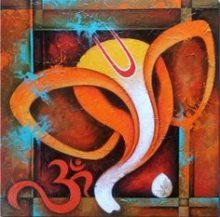 His big ears symbolize his limitless capacity for hearing.He hears our prayers regardless of how we recite them – he does not care whether or not we sing hymns in his praise, he considers our heartbeat and brainwaves to be forms of prayer.Any irregularity, whatever the cause, catches his attention.Being Ganesha, the head of the family, he rushes to our rescue.For these reasons, too, he is known as Vighnesha, “the lord who removes obstacles.”
His big ears symbolize his limitless capacity for hearing.He hears our prayers regardless of how we recite them – he does not care whether or not we sing hymns in his praise, he considers our heartbeat and brainwaves to be forms of prayer.Any irregularity, whatever the cause, catches his attention.Being Ganesha, the head of the family, he rushes to our rescue.For these reasons, too, he is known as Vighnesha, “the lord who removes obstacles.”
The fluid that sometimes flows from the temporal gland of male elephants flows constantly from Ganesha, and drawn by its sweet aroma insects drink the nectar. Intoxicated, they buzz around his ears, which he flaps gently in order to ward them off. This tells us metaphorically that Ganesha’s head, the treasure-house of wisdom, is so filled with the sweetness of love and compassion that it flows from him effortlessly and incessantly and is granted even to those who come to him with a noisy mind.
Set in his enormous head, Ganesha’s eyes are small because he has little use for them. However his third eye, the eye of intuition, is wide open, and he sees past, present, and future simultaneously. Seated as he is deep within every living and non-living entity, he sees everything. That is why he is called Adi Rishi, “the primordial seer.” He is the eternal source of knowledge – revelation flows through him. The scriptures refer to him as Parama Guru, “the master of all previous masters.”
The scriptures identify Ganesha with the sacred sound Om, and the shape of his trunk resembles the word written in Sanskrit. Because Om is the source of all mantras, repeating any mantra is tantamount to meditating on Ganesha.All sounds, words, and mantras in their dormant form rest in the muladhara chakra, where Ganesha resides.
The most subtle, vibrationless state of sound in the muladhara chakra is called “para.” At the behest of Ganesha,who presides over gravitational energy, a stirring arises in the muladhara chakra that can be detected only intuitively. This vibrationless vibration can be felt when it reaches the navel center; when it reaches the heart center, it assimilates the power of thinking; and it becomes audible when it reaches the throat center. Ganesha oversees this entire process. Without his assistance and guidance we can neither gain access to the muladhara center nor receive the ensuing revelation.That is why Ganesha is said to be the gatekeeper at the palace of the Divine Mother.
Though Ganesha’s feet are quite small, he outruns all the forces of the universe – because he pervades everything, he is already everywhere. Without moving, the lord of gravitational energy makes everything move. With his enormous body and tiny feet Ganesha dances to the song of the Divine Mother, and exhilarated by his movements, She joins in.Then, as mother and son perform their cosmic dance, all the arts and sciences spring forth. Unable to contain the divine ecstasy, the sages emerge from their absorption in Ganesha and assume their roles as our guides.
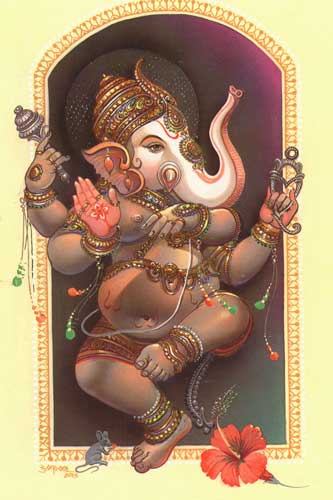 This cosmic dance symbolizes the process of kundalini awakening. The forces of darkness can cast their spell of slumber on us only as long as we are outside the pale of this dance. Thus Ganesha, the remover of obstacles, is the one who awakens the divine force in the form of kundalini shakti. He blesses us with shaktipata (the bestowing of divine energy). It is he who sends a sat guru (a true master) into our lives, and through his grace the forces of love, compassion, self-motivation, self-confidence, and determination unfold. Thus the scriptures assert that the door to the Divine Mother’s palace opens when Ganesha is pleased.
This cosmic dance symbolizes the process of kundalini awakening. The forces of darkness can cast their spell of slumber on us only as long as we are outside the pale of this dance. Thus Ganesha, the remover of obstacles, is the one who awakens the divine force in the form of kundalini shakti. He blesses us with shaktipata (the bestowing of divine energy). It is he who sends a sat guru (a true master) into our lives, and through his grace the forces of love, compassion, self-motivation, self-confidence, and determination unfold. Thus the scriptures assert that the door to the Divine Mother’s palace opens when Ganesha is pleased.
There are hundreds of ways to propitiate Ganesha and meditate on him. The tantric method, in conjunction with yantra sadhana, is precise and methodical. Those whose prolonged practice has gained them access to the muladhara center meditate on Ganesha by practicing the tantric method of kundalini yoga. To them, the human body is a yantra. Others draw the yantra of Ganesha on a gold, silver,or copper plate, on a silk cloth, on a wooden board, or on a piece of birch bark, and meditate on that.
From: Warrior of Light (India)
The Ganesh Mantra
From Mind Valley, here are 6 benefits to a regular practice of chanting the Ganesh Mantra. I’m sure there are many more.
- The Ganesh Mantra is known to activate the mind and various chakras of the body. This leads to better blood circulation and therefore improved metabolic rate in the body.
- It is said that it is best to chant the Ganesh Mantra before undertaking a new venture, as he is the bringer of success, prosperity, and good luck.
- Chanting the Ganesh Mantra also brings peace, or more literally – it removes all enemies from one’s path.
- It helps us focus.
- It brings clarity into our lives
- It is also said that if you chant the Ganesh Mantra 1008 times, it will remove fear from your heart.
What is the Ganesh mantra?
Well, actually there are a number of different Ganesh Mantras. The one we used for our original project was this one: Om Gam Ganapataye Namaha.
A loose translation might be:
- Om = The sound of the universe
- Gam = The secret power sound of Ganesh. It is his “seed syllable” or bija mantra.
- Ganapataye = Another name of Ganesh, the remover of obstacles.
- Namaha = I submit to a higher power.
The pronunciation is also pretty easy:
- Om = ohm or aum
- Gam = Somewhere between “gahm” and “gum”. In some dialects it is “guhng”.
- Ganapataye = gah-nah-paht-ah-yeh
- Namaha – nah-mah-hah
Repetition of this mantra over and over again brings peace, and is designed to help remove anything that might be blocking your progress. Some of us used the whole mantra, and some of us just used the bija or seed sound for the Ganesh Mantra, which is “Gam” and sounds like “gum.”
The mantra can be chanted aloud, or silently, or a combination of the two. You might want to do this as a regular meditation practice, or you can simply chant the mantra while on your way to work, whenever anything comes up that feels overwhelming, if you find yourself in a whirlpool of anxious thoughts, while walking, jogging, or even when falling asleep at night.
Awaken Shakti With The Ganesh Mantra
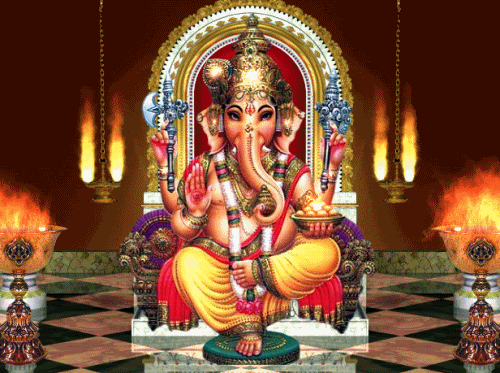
Here’s some info from Mind Body Green:
This is my favorite mantra to awaken Shakti, or the manifesting energy of the Universe, to stoke the fire of transformation within. I teach this mantra in classes, I sing it while driving in Los Angeles traffic and I have shared with with friends, family and students around the world because it’s easy and uplifting with the potential for great results.
According to the Buddhist Handbook, mantras are “highly compressed, power-packed formulas, usually of Sanskrit origin, which are charged with deep meaning and magical potency.” A mantra can be a word, sound or phrase which elevates or modifies consciousness through its meaning, sound, rhythm, tone and reflexology of the tongue against the palate of the mouth.
This particular mantra is “Om Gam Ganapataye Namaha,” which can be loosely translated to “Yo! Wake up Root Chakra energy of transformation so I can move through any obstacles in my life. Hooray!” Most importantly, we are calling upon the powerful energy of Ganesh, the elephant headed deity, who is widely revered as the Remover of Obstacles and the Lord of Beginnings.
According to Kundalini yoga, Ganesh, also referred to as Ganapataye, resides in the first chakra, called Muladhara (muladhara). Mula means “original,” and adhara means “foundation.” The muladhara chakra is the principal origin from which the manifesting energy of Shakti resides within each of us. When we awaken that energy, it helps us move through the Chakras with ease to activate a strong sense of self, express Divine love, communicate clearly and connect with our intuition.
This particular mantra is important because not only is it fun and catchy, but it also represents a willingness to release and move past the perceived obstacles in our lives. We can all make excuses for ourselves about why we cannot achieve our dreams, but you will have an easier time succeeding when you choose to focus on your goals rather than your challenges. So when you make the choice to chant this mantra, you are aligning yourself with your desired outcome and moving towards it with conviction.
I suggest you use this mantra when you want to clear the Chitta Vritti, or the anxious chatter of the mind. You can repeat this Mantra 108 times on your Mala beads or follow along with a video for a minute of chanting. You’ll find a bunch of them on YouTube. Most importantly, make it your own, find your voice and have fun. Remember, this is your life. Don’t let anything hold you back because you deserve the best.
Ganesha – Lord of Beginnings
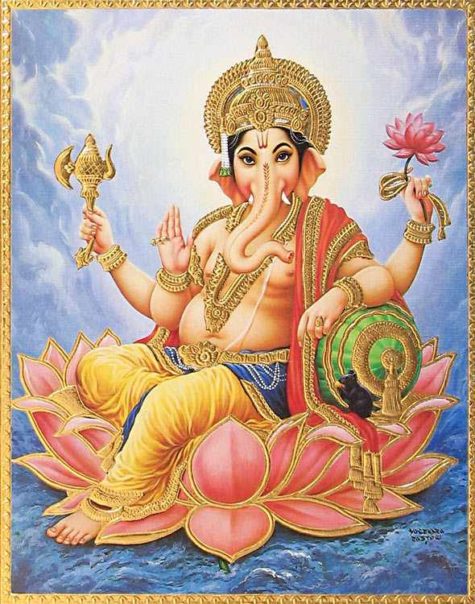
Elephant-headed Ganesha may be the most beloved deity of the modern Hindu pantheon; venerated by millions. He is invoked by Buddhists, Jains, and Neo-Pagans, too. He is benevolent and generous to all.
- Titles: Lord of New Beginnings; Lord of Obstacles; He Who Bestows Blessings
- Also known as: Ganapati
- Origin: India
- Color: White, Red, Pink
- Element: Water
- Numbers: 1, 3, 5
- Animals: Mouse, Snake
- Mount: Mouse
Lord of Beginnings, Ganesha’s blessings are sought before initiating any new enterprise. Ganesha is the Lord of Obstacles, removing but also creating them, sometimes from anger but sometimes just to attract further veneration. The flip-side of Ganesha is that he must be propitiated before new ventures lest he place obstacles in your path.
Ganesha bestows success, victory, prosperity, material comfort, romance, love, better six, and supernatural powers and skills to his devotees. He can block all these things, too, although he is unlikely to do so unless insulted and angered.
Ganesha is a generous, sympathetic spirit, quick to bestow favors. He is a trickster, but on behalf of his devotees and those he loves. Ganesha has a fast, volatile temper, but he calms down quickly too, and can be soothed and appeased. Just remember the old saying: “An elephant never forgets!”
- Ganesha is the first deity worshiped during Hindu rituals.
- His is the first image at the head of all processions.
- He is an indispensable component of all Hindu ceremonies except funeral rites.
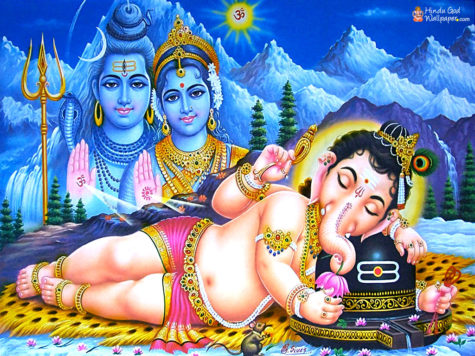
In The Beginning
Historical evidence indicates that Ganesha was known as early as 1200 BCE, however surviving depictions are rare before the fourth century CE. He was incorporated into the Hindu pantheon comparatively late, in approximately the 5th century.
Ganesha is believed to have begun his incarnation as a pre-Aryan elephant spirit venerated by jungle tribes. In addition to this other gifts, he was invoked for protection from elephant herds.
He was absorbed into the Hindu pantheon as the son of Shiva and Parvati. Various myths explain why Ganesha has an elephant head. In one, Parvati creates her son from the scrapings of her own skin. Ganesha was born while Shiva was away long-term practicing austerities.
Ganesha is extremely close to his mother. When she asked him to guard her privacy in the bath, he took up his position at the door. This was the moment Shiva returned. Father and son didn’t know each other. Shiva wished to see Parviti; Ganesha refused to let him pass. Shiva beheaded him. Parvati came to see the source of the commotion and was distraught. Now comprehending the situation, Shiva revived Ganesha but was forced to find a new head. The first to be had was an elephant’s.
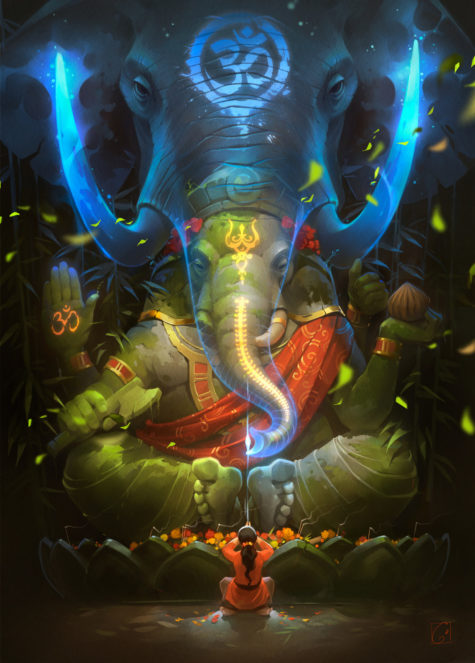
Petitioning Ganesha
Ganesha is lord of entrances, thresholds, and crossroads. Let him guard your door. It’s traditional to place his image above main entrance thresholds so that he is always encountered when entering.
Ganesha is happy to be venerated alongside other deities; however, never forget that he is the Lord of Beginnings. If you feed him, feed him first before any other spirits. There may be conflict if you venerate him alongside other spirits who also expect to be first served, for instance, Elegba.
- Ganesha heals physical, spiritual, and emotional ills.
- Ganesha has the power to liberate from the karma of past lives.
- He is invoked for children by the childless.
Petition him at a home altar or in a temple. Ganesha is the subject of a fertility ritual conducted at his temple in Madurai, India; allegedly if you bathe his image and circumambulate around it for forty-eight consecutive mornings, he will grant your wish for children.
Ganesha is a popular tantric deity, too. His trunk and single tusk are phallic symbols. Early Hindu texts suggest disapproval of Ganesha who was then associated with “orgiastic rituals.” He remains associated with Tantra among Buddhists. Ganesha communicates with devotees in dreams.
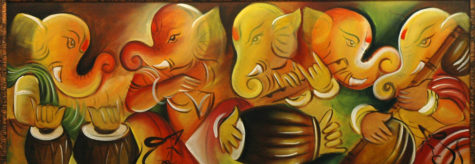
Favored People:
Ganesha will allegedly favor anyone who approaches him with a pure heart. He is the special patron of musicians who play the tabla and/or mridangam (percussion instruments), as well as authors, poets, and writers. In Thailand, Ganesha is considered patron of elephant trainers.
Manifestation:
Ganesha has an elephant’s head on a man’s pot-bellied body. He has one broken tusk. His skin usually has a rosy hue. His big ears signify his capacity to listen and hear. His forehead is marked with vermilion, indicating his tendency to involve himself in issues associated with women and his generosity toward female devotees.
Iconography:
There are countless images of Ganesha sitting, standing, dancing, or riding his mouse. Once you know what he looks like, he’s very recognizable.
Realm:
Ganesha’s home is a celestial realm called the Abode of Bliss (Svaanda Dhama). He lives in a marvelous palace surrounded by a forest of wish-fulfilling trees and an ocean of sugarcane juice.
Offerings:
Ganesha is easy to please, but he cannot be fooled. He will accept the most modest offerings but only if given with sincere intent and devotion. His favorite offering is said to be modaka, a type of sweet rice or wheat cake. Here’s a recipe: Recipe For Modaka. Allegedly the more modaka you give him, the more inclined his is to work on your behalf. Ganesha also accepts peanuts; fruits, especially bananas; sweets, candy, and sugarcane.
Source: The Encyclopedia of Spirits ~ Borrowed from The Powers That Be
Coloring Ganesha
If you enjoyed the dot-to-dot Ganesh, this will be even more fun. I found a bunch of different Ganesh coloring pages, and have uploaded them into a photo gallery. I think they are large enough to print and color, and if you have an app on your phone that allows such a thing, that’s fun too!
The Lord Who Is Hidden In All Things
Recipe For Modaka
The following recipe will make approximately 20 lime-sized modakas, a treat for the children, and a traditional offering to Lord Ganesha. It takes about two hours to make them.
Ingredients and Utensils:
- 1 lb rice flour
- 2 cups jaggery (or 2 cups brown sugar with 4 tbsp dark molasses added)
- 2 cups raw sesame seeds
- 2 grated coconuts (optional)
- 2 cups melted ghee (melted butter will also work)
- 1 tsp salt
- Banana leaf or waxed paper
- A flour sifter or fine sieve
- An iddli or vegetable steamer
Directions:
Roast the sesame seeds in a pan, without oil, until golden brown (5 to 10 minutes). Crack the seeds by rolling with a rolling pin or pounding. Add 4 tbsp ghee to the jaggery to soften it, and then mix in the sesame seeds and coconut thoroughly. (This mix may be refrigerated in jars for making quick sweets simply by adding a bit of ghee and shaping the dough into balls).
Next sift the rice flour and toast it without oil until it browns slightly – about 5 to 7 minutes. Spread it out on a tray or table top when done, and allow cooling completely.
While the rice flour is cooling, bring approximately a half-gallon of water, with a tsp of salt, to a rolling boil. Put the cooled, toasted rice flour in a bow. And make a well in the middle. Slowly pour a small amount of the hot water into the well and begin working it into the rice flour with your hands.
Keep adding small amounts of the hot water, and work the flour into a ball of dough. It should be moist but not wet when you put it out on the table or breadboard. Knead the dough thoroughly so it is even in moisture and texture.
Next, place water in the bottom of the steamer and bring to a full boil. Spread a thin coating of ghee or oil on a piece of banana leaf or waxed paper. Take a lump of dough half the size of a lime and work it in your hands for a moment to remove the air and then pat it out flat and round on the leaf, about as wide across as your palm. Make it a uniform thickness so it will cook evenly.
Place a lump of the sesame-jaggery-coconut mixture into the center and wrap the dough up around the mixture. Pinch the dough into a cone-shape over the stuffing and wrap the leaf or paper up around it. (The modakas can also be round if desired.) Repeat until you have enough to fill your steamer.
Place the assembled modakas in the steamer, spaced so as to not touch one another. Cover and steam until done (15 to 20 minutes). While they cook you can prepare the next batch. When cool enough to handle, dip the modakas in melted ghee. Now they are ready to offer.
from Loving Ganesa
by Satguru Sivaya Subramuniyaswam
Make a Papier Mache Ganesh
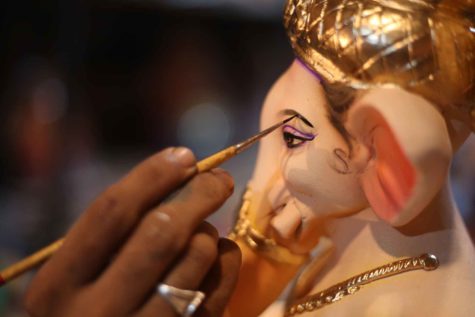 This is a simple method for a paper mache Ganesh. Some artistic ability is helpful, but if you are willing to simply get in there and have fun, it might surprise you how easy it could turn out to be!
This is a simple method for a paper mache Ganesh. Some artistic ability is helpful, but if you are willing to simply get in there and have fun, it might surprise you how easy it could turn out to be!
The materials needed are:
- Paper mache
- Latex or other water-based paint in a variety of colors
- Gold-leaf or metallic gold paint
- Paint brushes
- Sand paper
- Putty or joint compound
- Miscellaneous ornaments and cloth for dressing the image
- Replicas of the various implements he will be holding
Instructions:
- Mix paper mache to a firm but homogeneously wet consistency.
- Make an armature (skeleton) of wood, Styrofoam, or similar material.
- Create the image by covering the armature with paper mache.
- Make implements for each hand and make sure they can be inserted and glued later when the image is dry
- Brush the exterior smooth with a wet brush.
- Let the image dry in a cool place, away from the sunlight. (Drying time is usually one month for every foot in height for a clay image, three weeks for paper mache.)
- When dry, sand with coarse, then fine sandpaper
- Fill cracks with putty or joint compound.
- Sand again
- Apply a white primer and sand with very fine sandpaper.
- Make the image dust-free.
- Paint the torso, head, trunk, and limbs
- Use red paint and a fine brush for the Aum, swastika, and other – symbols.
- Paint, decorate, and/or assemble the various implements
- Place appropriate dress (traditionally white or red silk) upon the image.
- Glue the implements into the hands
- Decorate the image with ornaments, flowers, etc.
adapted from Loving Ganesa
by Satguru Sivaya Subramuniyaswami
An alternative method can be explored with this visual tutorial from Hobby Ideas:
Ganesh Chaturthi
From the Pagan Calendar, we have this great info about the Ganesh Chaturthi:
Vinayaka Chaturthi – also known as Ganesh Chaturthi – is a Hindu holiday festival that is observed on on the fourth waxing moon day during the month of Bhadrapada. This is around August or September on the Gregorian Calendar. The purpose of this festival is to honor the very popular Hindu God Ganesha, also known as Vinayaka.
- Dates vary from year to year.
- In 2018, the festival runs from September 12 thru Sept 23.
The concept of Ganesh Chaturthi is that Ganesha comes to the home of his devotees on Ganesh Chaturthi day. He brings auspiciousness, hope, success and happiness to all homes. During His brief stay, He removes all obstacles. While returning He takes with him all problems and unhappiness.
Vinayaka Chaturthi is a festival that allows people to call on the power of Ganesh and to receive help from him in removing all of the obstacles that hinder their spiritual or mental path. It is also a time to ask for help in developing spiritual strength and resolve. It is a festival of great hope, joy and celebration that can be enjoyed by everyone regardless of class or wealth.
This remains one of the most widely celebrated festivals in the Country, partly because Ganesh is one of the most popular deities for worship. Ganesha, the elephant-headed son of Shiva and Parvati, is the supreme god of knowledge, wisdom, prosperity and good fortune. He is the Lord who is first worshiped before any holy occasion or puja.
His blessings are often invoked at religious ceremonies as he is the one who can remove all obstacles to success, particularly when people are starting a new business or enterprise. Ganesh is known as the giver of fortune and one who can help to avoid natural calamities. Ganesh is also the patron god of travelling.
Lord Vinayaka is revered as the preserver of all good things and prevents Vigna (meaning obstruction/bad omen). His motto is Shubh-Laabh (good prospect and good prosperity).
The Significance of the Festival
Hindus believe that during Ganesh Chaturthi, Lord Ganesh visits his people on the earth to personally attend to their prayers. Therefore the divine energy of Lord Ganesh descends on the earth in large measures during the event. The idols of Ganesh newly bought and installed act as antennas to receive the energies of Lord Ganesh and transfer them to the people during worship. After the worship, this is why the idols specially installed for the puja are immersed marking the sendoff.
How the Ganesh Chaturthi is celebrated:
Ganesh Chaturthi is celebrated with great devotion all over India. People bring home murtis (Idols) of Lord Ganesha and celebrate the festival by worshiping the Lord in a special way for a day and a half, 3 days, 5 days, 7 days or 11 days depending on the family tradition and commitment of each individual.
In certain parts of India, such as Andhra Pradesh and Maharashtra, the festival is celebrated for ten days and is a very public occasion. Elsewhere it may celebrated in homes, where hymns are sung and offerings made to Ganesh. Sweets are a common offering as Hindu legend has it that Ganesh liked them. On the last day of worship the idol is taken out in a colorful and musical procession to be immersed traditionally at a beach.
Rituals during the festival include:
- Pranapratishhtha – the process of infusing the deity into a murti or idol.
Several months before the start of Vinayaka Chaturthi, a large clay statue of Ganesha is crafted. There is no set size limit for this murti, it can be smaller than an inch or be over twenty feet tall, depending on the person making it. This murti is then either placed in homes or set up in specially made tents so that people can pay respect to it.
If you are interested in making one of your own, here’s a link to a short simple tutorial on how to make one out of paper mache. Some artistic ability is helpful but not required. Make A Paper Mache Ganesh
Ganesh Chaturthi starts with the installation of these Ganesh statues in colorfully decorated homes and specially erected temporary structures mantapas (pandals or colorful temporary shrines) in every locality. The mantapas are decorated specially for the festival, either by using decorative items like flower garlands, small banana saplings, lights, etc or are theme based decorations, which depict religious themes or current events.
The statues are worshiped with families and friends. The priest, usually clad in red silk dhoti and shawl, then invokes life into the statue amidst the chanting of mantras. This ritual, also known as Pranapratishhtha, is done to breathe life into the idol.
- Shhodashopachara – 16 forms of paying tribute to Ganesha.
After life is breathed into the image of Ganesh, people pay respect to the murti by offering it all kinds of different items. The offerings include 21 durva (trefoil) blades of grass, red flowers, coconut, jaggery, 21 modakas. The statue is anointed with Kumkum and Sandalwood paste. Vedic hymns from the Rig Veda, the Ganapati Atharva Shirsha Upanishad, and the Ganesha stotra from the Narada Purana are chanted.
For the next ten days, the statue is worshiped.
- Uttar Puja – saying farewell before the murti is moved.
Uttar Puja is performed in order to provide a farewell to Lord Ganesh just before the immersion. Here is the step by step procedure of Uttar Puja.
Light a lamp near the idol and decorate the idol with flowers. The puja will consist of offering Achamaniyam (water to drink), Sankalp (determination), chandanarpan (sandal paste), pushpa puja (puja with flowers), Durvarpan (offering durva grass), dhopp and deep darshan (offering incense and camphor light), Nivedan (offering some dishes and fruits). Say the prayers, chant Ganesh mantras and then do arati. Then do namaskar and move the idol a little with your right hand to mark the conclusion of uttar puja.
- Ganpati Visarjan – immersion of the idol in the river.
On the eleventh day, after the Uttar puja, the Ganesh idols are taken in procession with a huge fanfare to the water bodies. The crowds shout the names of Ganesh in ecstasy and make the procession a colorful and vibrant event. The idols taken in the procession are of different sizes, models and colors. They are carried through the streets for all to see. When this has concluded, people once again pay homage one last time before they are taken to the river and submersed.
The divine energies in the idols are transferred to the waters and then to the larger world. Therefore through the process of Visarjan, three objectives of the devotees are fulfilled namely saying thanks to Ganesh for the favors received, giving a sendoff to the Lord and sending the divine powers of the Lord for the benefit of all.
The idols are immersed one by one in the waters either manually or with the help of a crane. Usually, curd rice or puffed rice is made a bundle and sent along with the idol as a mark of giving food for the deity to have while journeying. After the visarjan, some sand is collected from the spot and sprinkled around the home.
- Alternatively:
Many of the Ganesh idols will be placed outside under Bodhi Trees (Sacred Fig). The Bodhi tree is revered as a great source of remedies and is used to treat up to 50 different ailments. It also has a unique ability in that it can produce Oxygen at night-time instead of Carbon Dioxide. These healthy aspects of the tree make it a popular place for people to go to worship, as it is seen a great healer to naturally cure illnesses.
Performing A Puja At Home:
Every Hindu puja starts with the invocation of God in the object of worship in order to accept the puja and prayers. After the puja, there is a ritual called ‘Yathasthan’ meaning giving a sendoff to the deity worshiped. This is the spirit and logic behind Ganesh Visarjan also. Spiritually, this process prepares a man to move from the form to the formless state of God.
Here are the things which you will need for Ganesh Chaturthi Puja.
- An idol of Lord Ganesh.
- Chandan or sandalwood paste.
- Red flowers, preferably Hibiscus flowers.
- Incense sticks.
- Durva grass.
- Modakas (here’s a recipe) or any sweet made at home after taking bath and without having any food.
- Some fruits.
- A Chaurang or elevated table to place the idol.
- A cloth to cover the table and things to decorate it like lights.
- Diya to light in front of the idol for Aarti.
Preparation for Ganesh Chaturthi Puja at Home
Sweep and wipe clean your house. Bring the idol of Ganesh at home and you can invite your friends and relatives for the Puja. Let your entire family gather at the time of Puja. Recite Ganesh Shlokas to welcome the Lord in your house.
Many families invite Pandits or Brahmins to do Ganesh Chaturthi Puja at home so that they can perform the Puja of Lord Ganesh the right way. For any Puja or Vrat you need two things – cleanliness and devotion. This will help you get the blessings of Lord Ganesh.
- Clean your house and take bath. Wear fresh clothes and get ready for the puja.
- Prepare the Ganesh mandap with coconut or banana leaves. You can use mango leaves and flowers also to decorate it. Some decorate it with leaves of the Ashoka tree.
- A pot filled with water and rice is installed near the idol of Lord Ganesh.
- Now place the idol of Lord Ganesh saying ‘Om Ganeshay Namah’.
- Start the Puja by chanting 108 names of Lord Ganesh or chant simple Ganesh mantras.
- Light the Diya or lamp and offer Aarti to the Lord by singing hymns especially dedicated to Ganesh or Ganesh Aarti.
- Offer Naivaidya of special recipes and fruits to Ganesh Jee.
There is a significance of number 21 in this Puja and so people offer 21 Durva grass blades and 21 Modaks. 21 signify – 5 organs of perception, 5 organs of action, 5 vital airs, 5 elements and the mind.
However, when you are performing Ganesh Chaturthi Puja at home you can be flexible. All you need to have is clean body and mind and the thing that is most important is devotion and not the ritual. So, try to keep things simple and concentrate on the Puja.
